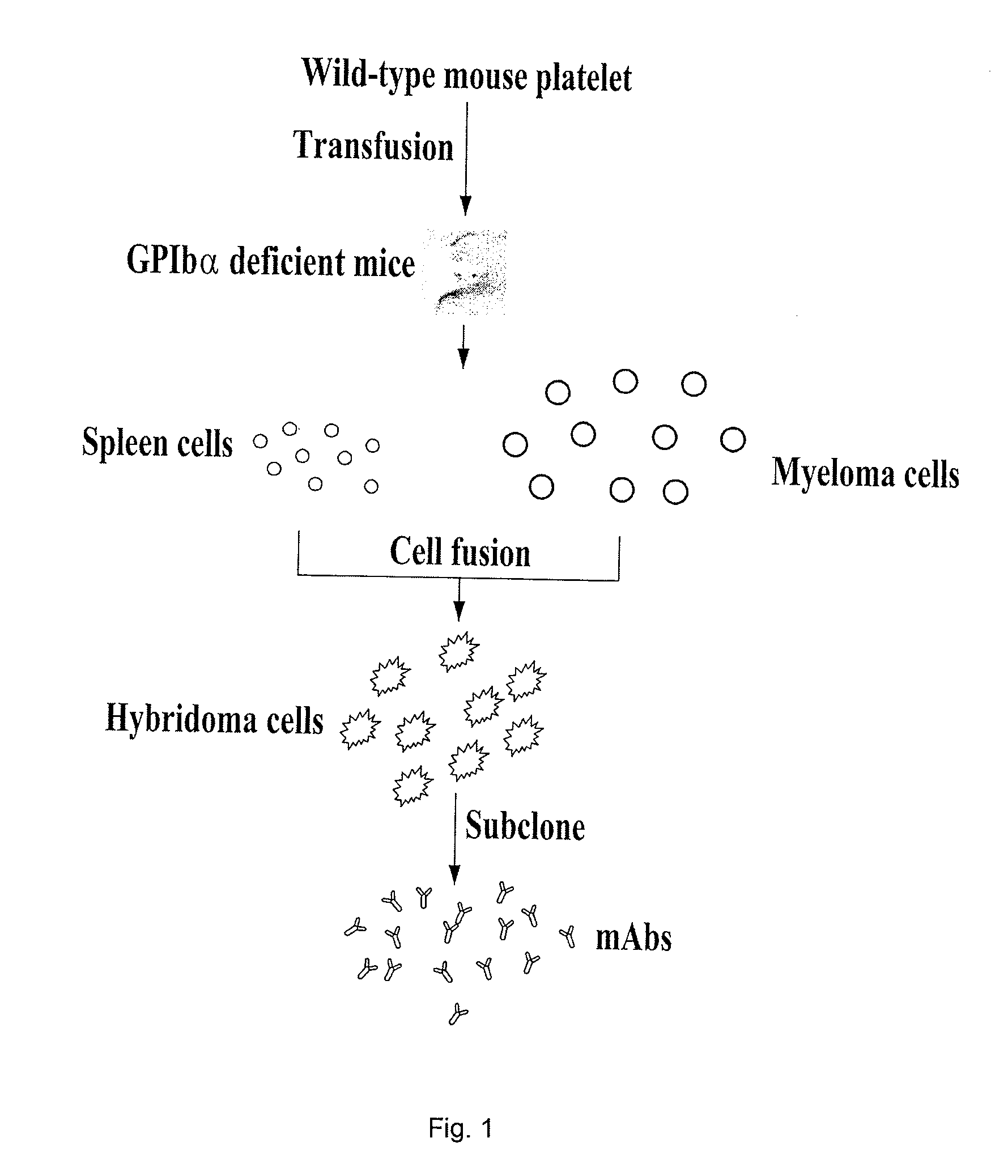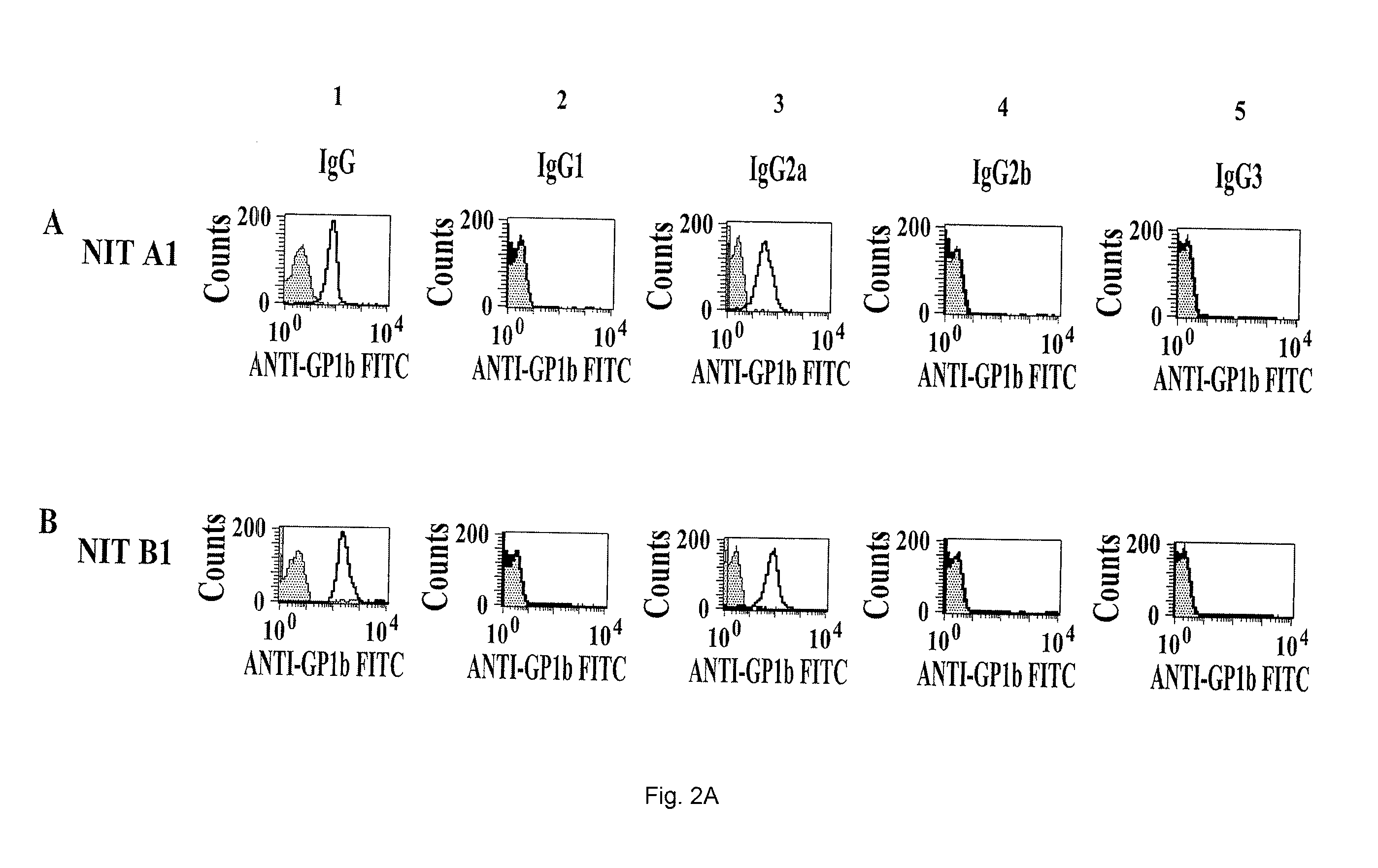ANTIBODIES AGAINST GPIb alpha
- Summary
- Abstract
- Description
- Claims
- Application Information
AI Technical Summary
Benefits of technology
Problems solved by technology
Method used
Image
Examples
example i
Production of the Monoclonal Antibodies Against GPIbα
[0059]Monoclonal antibodies were produced in accordance with the scheme illustrated in FIG. 1. Briefly, BALB / C wild type mice were bled under ether anesthesia from retro-orbital plexus using heparin-coated glass capillary tubes. The blood was collected into a tube containing 3% ACD (1 / 9, v / v). Platelet rich plasma was obtained by centrifugation at 300 g for 7 minutes. Platelets were then isolated from the platelet rich plasma using a Sepharose 2B column in PIPES buffer (PIPES 5 mM, NaCl 1.37 mM, KCl 4 mM, Glucose 0.1%, pH 7.0) as previously described (Ni, H. et al. 2000. J Clin Invest 106: 385-392; Yang, H. et al. 2006 J Thromb Haemost 4: 2230-2237; Reheman A. et al. Blood. 2009; February 19. 113: 1809-1817). GPIbα-deficient BALB / C mice, 6 to 8 weeks of age, were transfused with 1×108 these gel-filtered BALB / c wild-type mouse platelets for 6 times, once a week. Transfused GPIbαdeficient BALB / C mice spleen cells were fused with mou...
example ii
Subtypes Characterization of the Monoclonal Antibodies Specific for GPIbα
[0061]Washed mouse platelets (1×106) were incubated one hour with PBS (control), or a mAb produced according to the protocol set forth in Example I. The platelets were then stained with FITC-labeled goat anti-mouse IgG, IgG1, IgG2a, IgG2b or IgG3 (Sigma) for 45 min. Samples were analyzed by flow cytometry (FACScan™ Becton Dickinson).
[0062]As indicated on FIGS. 2A and 2B, the NIT-A1, B1 and NIT-F1 clones are of the IgG2a subtype; the NIT-C1, NIT D1, NIT G1, H1 and I1 clones of the IgG1 subtype and the NIT E1 clone of the IgG2b subtype.
Example III
Bindings Characteristics of the Monoclonal Antibodies Specific for GPIbα
[0063]As shown in Example II, the monoclonal antibodies produced in Example I were shown to be capable of recognizing mouse platelets.
[0064]In order to assess if the monoclonal antibodies produced in Example I are also capable of recognizing human platelets, washed human platelets (1×106) were incuba...
example iii
Modulation of Platelet Aggregation by the Monoclonal Antibodies Specific for GPIbα
[0067]Mouse platelets (FIG. 4) were incubated with PBS (control), or 40 μg / mL of a mAb produced according to the protocol set forth in Example I (NIT A1, NIT B1, NIT E1, NIT F1, NIT G1, NIT H1 or NIT I1) then stimulated with botrocetin (20 μg / mL). Platelet aggregation (light transmission) was monitored over 16 min using a computerized Chrono-log aggregometer (Chrono-Log Corporation, Havertown, Pa., USA). As shown on FIG. 4, NIT A1, NIT B1, NIT F1, NIT G1, or NIT I1 significantly inhibited mouse platelet aggregation, NIT A1, NIT B1 and NIT F1 completely inhibited mouse platelet aggregation while NIT E1 and NIT H1 did not inhibit mouse platelet aggregation.
[0068]Human platelets (FIG. 5) were incubated with PBS (control), or 40 μg / mL of a mAb produced according to the protocol set forth in Example I (NIT A1, NIT B1, NIT F1) then stimulated with ristocetin (1.5 μg / mL). Platelet aggregation (light transmiss...
PUM
| Property | Measurement | Unit |
|---|---|---|
| Time | aaaaa | aaaaa |
| Size | aaaaa | aaaaa |
| Adhesion strength | aaaaa | aaaaa |
Abstract
Description
Claims
Application Information
 Login to View More
Login to View More - R&D
- Intellectual Property
- Life Sciences
- Materials
- Tech Scout
- Unparalleled Data Quality
- Higher Quality Content
- 60% Fewer Hallucinations
Browse by: Latest US Patents, China's latest patents, Technical Efficacy Thesaurus, Application Domain, Technology Topic, Popular Technical Reports.
© 2025 PatSnap. All rights reserved.Legal|Privacy policy|Modern Slavery Act Transparency Statement|Sitemap|About US| Contact US: help@patsnap.com



